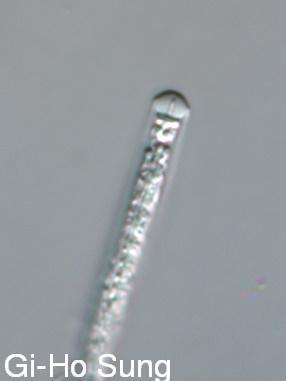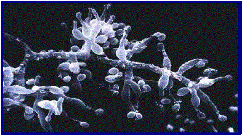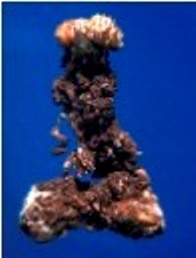ReproductionReproduction
Do I have sex? How do I keep my lineage going?
No, C. subsessilis does not have sex - by the concept that some people may be thinking. But, C. subsessilis, like all other fungi have an alternation of generations life cycle. Which means that this organism has sexual reproduction as well as asexual reproduction states.
The sexual state of this fungus is actually the fruiting body itself. Cordyceps subsessilis, or the part that is commonly associated with it is the sexual reproducing part. Like other Ascomycetes, C. subsessilis produces a fruiting body called an ascocarp. In the inside of this ascocarp are lots of cylindrical shaped asci (sac-like spore holder). Within these asci, ascospores are located, to be more specific, eight ascospores are located there.
 Why are there exactly eight ascospores in an ascus?
This is so because of the way they are produced. It may seem odd, but to
produce these spores, it has to go throw both meiosis and mitosis. It
begins with two mycelium coming together and going through a process called
plasmogamy (when two cells come together with two haploid nuclei, but the nuclei
don't fuse immediately). Once this occurs, the fungus has a new ploidy
level, n + n, this state is called dikaryon. After growing for a while by
means of mitosis, a signal is received causing a fruiting body to be formed.
After the fruiting body is formed, a cell in the interior of the ascocarp goes
through karyogamy (when two haploid nuclei come together to form a diploid
nucleus) to produce a diploid cell to go through meiosis. Then, meiosis
occurs creating four haploid (and genetically recombined) daughter cells.
After that, mitosis immediately occurs creating eight ascospores.
Why are there exactly eight ascospores in an ascus?
This is so because of the way they are produced. It may seem odd, but to
produce these spores, it has to go throw both meiosis and mitosis. It
begins with two mycelium coming together and going through a process called
plasmogamy (when two cells come together with two haploid nuclei, but the nuclei
don't fuse immediately). Once this occurs, the fungus has a new ploidy
level, n + n, this state is called dikaryon. After growing for a while by
means of mitosis, a signal is received causing a fruiting body to be formed.
After the fruiting body is formed, a cell in the interior of the ascocarp goes
through karyogamy (when two haploid nuclei come together to form a diploid
nucleus) to produce a diploid cell to go through meiosis. Then, meiosis
occurs creating four haploid (and genetically recombined) daughter cells.
After that, mitosis immediately occurs creating eight ascospores.
 The asexually reproducing state of C. subsessilis
is a mold form called Tolypocladium inflatum. To begin with, T.
inflatum, a mold that lives in the soil of certain areas, was thought to be
the only state of this organism. It also feeds off beetle larvae just like
the sexually producing state. But thanks to a field mycology class and the
help of Kathie Hodge, we find out that that is not all correct.
The asexually reproducing state of C. subsessilis
is a mold form called Tolypocladium inflatum. To begin with, T.
inflatum, a mold that lives in the soil of certain areas, was thought to be
the only state of this organism. It also feeds off beetle larvae just like
the sexually producing state. But thanks to a field mycology class and the
help of Kathie Hodge, we find out that that is not all correct.
 Tolypocladium inflatum produces asexually by
means of conidia (a sporangium where the spores are produced externally). Unlike
the ascus, the spores are produced externally and only by mitosis. In this
life cycle, a haploid mycelium is growing and continues to grow via mitosis.
When it comes time to produce spores, the haploid cell goes through mitosis and
produces an identical cell to itself which is produced on the conidia.
Tolypocladium inflatum produces asexually by
means of conidia (a sporangium where the spores are produced externally). Unlike
the ascus, the spores are produced externally and only by mitosis. In this
life cycle, a haploid mycelium is growing and continues to grow via mitosis.
When it comes time to produce spores, the haploid cell goes through mitosis and
produces an identical cell to itself which is produced on the conidia.
In both cases, all spores are spread via the wind. In the sexual state, the ascus has to expel its contents because the spores are internally produced. In the case of the conidia, the spores are able to become dislodged and float away.
If you are fascinated by this organism and want to continue entertaining yourself, click here to continue on to interactions.
If you are tired of learning about this fungus, you may return to the home page by clicking here.
